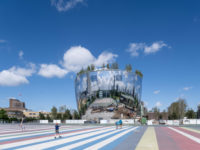Rotterdam
When I went to Rotterdam to see the largest single building in The Netherlands, the eponymous De Rotterdam by OMA, it reminded me of something. But I couldn't put my finger on it. Walking back over UNStudio's elegantly sculptural 1996 Erasmus Bridge crossing the River Maas, I turned to take a photograph. Back home in London, I showed it to a friend. “Easter Island statues,” she said, instantly. Spot on.It's surely not intended, but it's there: the hauteur, the sense of enigmatic ancestor-guardians lining the water's edge, but also the anonymity. The Polynesian statues are simplified representations of human heads. They vary, but there is no individual human expression. Like De Rotterdam, they are mostly arranged on strongly expressed horizontal plinths.
Koolhaas, of course, has written persuasively about “bigness” as an architectural determinant, eclipsing the more usually cited design generators of composition, scale, proportion, and detail. However, the rhetoric and the reality are at odds here: this building is a highly considered piece of architecture, even if its initial impact is meant to be that it's just an assemblage of generic blocks. Its design was shaped by the presence of the nearby bridge and sweeping roadway: this is intentionally a moving-picture building, your view of it shifting as you cross the bridge. As with OMA's scheme for a building at Ground Zero in Manhattan, which it visually resembles (see slide 7 in slide show), it is a waterfront structure designed to present different characters as you move past—sometimes solid, sometimes broken.
Once inside, you notice traces of the OMA design hand, from reception desks through triple-height lobbies, right down to indicator panels in the lifts and the design of the hotel rooms, bars, and restaurants. While the interiors have a somewhat industrial aesthetic in places, elsewhere the firm juxtaposes fine detail and rich materials—brass, timber, translucent plastics.
De Rotterdam is named for the succession of Dutch ocean liners of that name which used to depart from the Wilhelminapier: some of the old dockside brick buildings still remain near the new complex. It is part of an urban regeneration project that includes earlier residential and office towers by Álvaro Siza (2007'10), Renzo Piano (1997'2000), Norman Foster (1995'2000), and Mecanoo (1999'2002). These form a motley bunch, none being anywhere near the best work of the architects in question. Despite—or maybe because of—having taken the longest to complete, OMA's De Rotterdam is clearly the king of this architectural jungle. It is 350 feet wide, 490 feet high and 118 feet deep. Its almost cartoon-like rendering of blocks does not alter the fact that it has something else, which you could call class. It has authority and presence without stridency.
The 1.74 million-square-foot project has a broadly tripartite mix of functions: 240 apartments in the western tower, 775,000 square feet of offices in the center, and a 278-room hotel at the eastern end, though the functions overlap in places. In the podium there are conference and restaurant spaces, retail, a health club, and a multilevel 650-vehicle garage. Parts of the building, though, remain empty. The podium provides a continuous tall arcade at ground level, approached from the rear, non-river, side. On the inside, a long concourse connects the various reception lobbies. This drawn-out communal space can be confusing and offers some odd juxtapositions: in the approach to the main restaurant and bar, for example, you stare across an atrium to the cars in the garage. The building is so big that, in places, you feel the client hasn't worked out what to do with it all.
As a built diagram of stacked, split volumes, defined entirely by property economics, De Rotterdam tries its best not to be iconic. Yet it has that strange, otherworldly Easter Island presence. Rem and OMA have constructed a totem to market forces. I struggle to love it, but can't help admiring its obstinate strength of character.
People
Formal name of building:
Location:
Completion Date:
Gross square footage:
Total project cost:
Total construction cost:
Client:
Owner:
Financier:
Architect's firm name, address, phone, and fax number:
Personnel in architect's firm who should receive special credit: All architects are registered architect in The Netherlands, Rem Koolhaas is registered architect in USA.
Engineers:
Consultant(s):
General contractor: Size: 1.75 million square feet Cost: $475 million (total); $338 million (construction) Completion date: November 2013 |
Products
Structural system
Exterior cladding
Glazing
Doors
Interior finishes
Furnishings
Conveyance
Plumbing |













Post a comment to this article
Report Abusive Comment